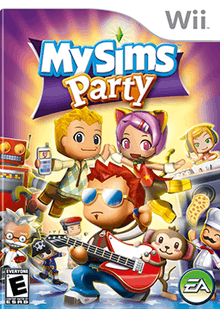MySims Party
MySims Party is a video game developed and published by Electronic Arts as a spinoff to Maxis' The Sims franchise for the Nintendo DS and Wii in 2009. It is the third game in the MySims series. It consists of 50+ mini-games which can be played with up to 4 players. The game was released on March 10, 2009 in North America.[1]
| MySims Party | |
|---|---|
 NTSC cover art | |
| Developer(s) | EA Redwood Shores (Wii) Hudson Soft (Nintendo DS) |
| Publisher(s) | Electronic Arts |
| Series | The Sims |
| Engine | Havok |
| Platform(s) | Wii, Nintendo DS |
| Release | Nintendo DS, Wii
|
| Genre(s) | Party, life simulation |
| Mode(s) | Single-player, multiplayer |
Gameplay
Wii version
The Wii version of MySims Party takes a departure from The Sims franchise and the other MySims Games and begins with a character moving into a run-down town with a mayor desperate to bring residents back. The player's job is to enter festivals and win to bring new people into town. Players must collect points during these minigames to gain new characters and monuments and in return are given new playable characters, and outfits for their Sim. As the town's population increases, new areas are unlocked.
You can also interact with citizens by talking to them. You can also customize your character in many different items you can build that has the option to change your character. Unlike other games in The Sims franchise, your Sim does not have needs or wants.
In the Nintendo Wii version of MySims Party only the Wii Remote is used to play minigames. You also move the cursor around the screen to get to different parts of the menu. You can also use the Wii Remote to move around town.
Nintendo DS version
The Nintendo DS version of MySims Party takes place in a run-down town with the player tasked with the job of bringing residents into the island. This is accomplished by playing minigames for the locals who lives in your town and after you're done with a certain festival you earn stars. Players collect stars to unlock other parts of town as well as new minigames and new items in stores. As more stars are collected, the town grows and mini games are unlocked.
You can also interact with tourist and residents. You can play certain minigames and depends how you do, you unlock them as a playable character. You can also change your Sim's style in any different way in the wardrobe and you can store items in the drawer. Unlike other games in The Sims franchise, Sims do not have needs or wants but sleeping can be optional.
The Nintendo DS version of MySims supports touch screen and microphone functionality. The touch screen is used for talking and movement as well as placing and moving houses or furniture. Other buttons may control specific tasks such as taking photos or initiating conversation. This version also features a number of mini games.
Reception
| Reception | ||||||||||||||||||
|---|---|---|---|---|---|---|---|---|---|---|---|---|---|---|---|---|---|---|
| ||||||||||||||||||
The game received mixed reviews among critics. Reviews for the DS version were generally more positive, with the Wii version receiving big criticism on use of controls. IGN said "At best, the mini-games of MySims Party offer a simple diversion for children. At worst, they are a mess of poorly-implemented waggle controls.", about the Wii version, and "At best, the mini-games of MySims Party offer a simple diversion for children. At worst, they are an uninspired cash-in trying to coast on Electronic Arts' MySims property." for the DS version. However, they praised the "single-card multiplayer" mode.[3]
References
- "Puffins: Island Adventure, MySims Party, and Gamecube Re-releases on Wii". KidzWorld. Retrieved 2009-03-05.
- GameRankings.com